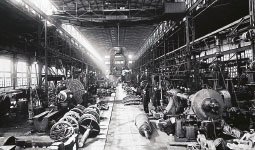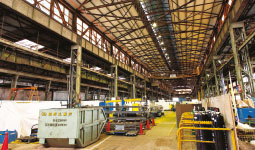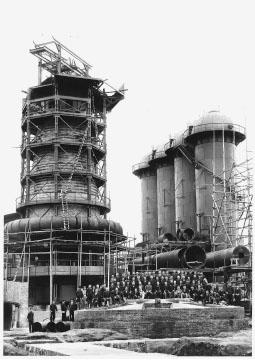Home > Highlighting JAPAN > Highlighting Japan October 2018 > From Meiji to the Present: Looking Back on 150 Years of Progress
Highlighting JAPAN


Meiji Innovation Heats Up: The Yawata Steel Works
In 2015, UNESCO registered a collective World Heritage Site representing Japan’s Meiji industrial revolution in iron and steel, shipbuilding and coal mining that includes twenty-three components spanning eight prefectures. One of them—the Yawata Steel Works in Kitakyushu—is a prime example of the first successful technology transfer from the West to a non-Western nation.
Japan’s steel, iron, shipbuilding and coal-mining industries made great strides from the end of the Edo Period (1603-1867) until the end of the Meiji Period (1868-1912). That progress started at Japan’s first reverberatory furnaces in Saga, spreading to Kagoshima, Hagi, Nirayama and Mito. Japan’s first charcoal blast furnace was built in Kamaishi, which led to the creation of the Yawata Steel Works. Rapid railway construction and the rise of various industries at the outset of the Meiji Period were generating intense demand for iron and steel.
The government therefore decided to establish a state-run steel mill, and chose the village of Yawata—which faces Dokai Bay in Kitakyushu and is near the Chikuho coalfield in Fukuoka Prefecture—as the site. The first technical supervisor of what would become the Yawata Steel Works, Michitaro Oshima, traveled to Gutehoffnungshütte of Germany to order the necessary equipment. Construction started on the planned facility with a blast furnace that would produce 160 tons of pig iron, along with an integrated iron and steel works factory that would turn the metal into products. Three years later the No. 1 blast furnace was completed, blown-in the following year, and began operating in 1901.
Just a year and a half later, however, the No. 1 blast furnace was shut down, plagued by inadequate funding, construction problems and poor operating technology. Since the German engineers who had provided technical guidance had gone home, the Japanese staff tried to fix the issue themselves. Unfortunately the second blowing-in was also a failure.
Enter Dr. Noro Kageyoshi, a central figure on the country’s steel industry research committee who had rebuilt the blast furnace in Kamaishi. He investigated the causes of the Yawata failure, remodeled the blast furnace, and finally stabilized its operation with the third blowing-in. The No. 2 blast furnace was completed the following year. The No. 3 blast furnace—the first built solely by Japanese—stabilized immediately after going online in 1909. The following year, its tenth, the Yawata Steel Works turned a profit for the first time.
Nippon Steel & Sumitomo Metal Yawata Steel Works incorporates some of the old facilities, and some are still in operation. One is the former repair shop, which is currently used as an operations facility. Built in 1900, it is Japan’s oldest existing steel-framed building and has undergone three expansions.
The other World Heritage Site here, the Onga River Pumping Station, is on the east bank of the Onga River about eleven kilometers from the steelworks. It supplies most of the water needed for production at Yawata. Its power source has changed from steam to electricity, and the pump has been replaced, but the red-brick outer walls and the roof are as they were.
In addition, the first head office is a beautiful red-brick building with a dome-shaped roof and Western architecture, and was used until 1922. The former forge shop was completed in the same year as the repair shop, and following expansion and relocation it became the steelworks museum. The most famous steel building at the time was the National Diet Building. It required 9,500 tons of steel, which was transported to Tokyo by ship. The steel framework was completed in 1927, and the Diet Building was finished in 1936.
In 1910, the Yawata Steel Works opened a training institute and established an in-house research organization. It was rare anywhere at that time for a business to conduct its own research. Their unwavering efforts and a broad, forward-thinking outlook led to better technology.
Yawata is a symbol of what elevated Japan to a technological superpower, and the people employed here take pride in the accumulated history and accomplishments of their predecessors. While reinforcing its role as a production source of steel exports to other Asian countries, the Yawata Steel Works continues to refine its manufacturing values and competitiveness, looking to the future as well as the past.
© 2009 Cabinet Office, Government of Japan










